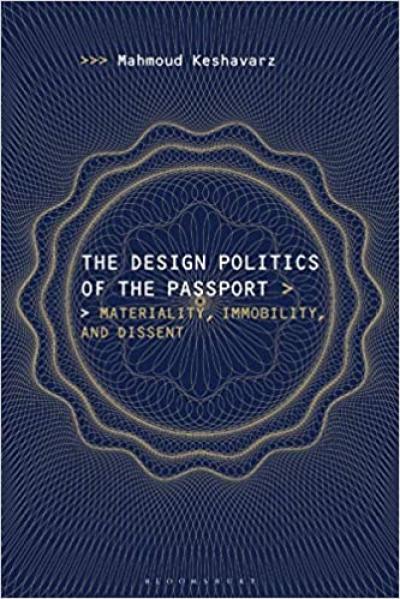Book Review: The Design Politics of the Passport: Materiality, Immobility, and Dissent
Posted:
Time to read:
Post by Samuel Singler. Samuel is a PhD candidate at the Centre for Criminology, University of Oxford. His PhD research critically interrogates the role of novel surveillance and border security technologies in the global criminalization of migration. He is on Twitter @SamuelSingler.
Review of The Design Politics of the Passport: Materiality, Immobility, and Dissent by Mahmoud Keshavarz (Bloomsbury 2019).

While focusing on ‘the design politics of the passport,’ Keshavarz also interrogates the relationship between academic critique and political practice in general. This analytical move is a timely one, given increasing recognition among critical scholars that, as Jonathan Luke Austin recently argued, ‘knowledge production (i.e. epistemics) is typically a necessary but rarely a sufficient source of sustained world-political change.’ Keshavarz’s critical discussion of design ethics echoes and empirically expands upon philosophical discussions of the morality of materiality by scholars such as Peter-Paul Verbeek, and provides a framework for rethinking political action in terms of the material practices of design. This, in my view, is the most important contribution of the book, particularly given the riveting primary interview material in Chapters 4 and 5.
The introductory chapter provides an illuminating discussion of the many meanings of design and the political stakes of the book, as well as a recognition of the contingency and complexity of Keshavarz’s analysis: ‘I do not attempt to find a single designer behind the passport but try to explore a regime of design practices that can be examined, opened up, and challenged through the single artifact of the passport’ (pp. 12-13). This appreciation of complexity and multiplicity is immediately reflected in Chapter 2, which examines the ‘histories,’ rather than a singular authoritative ‘history’ of the passport. Here Keshavarz analyzes the historical development of passports through a range of ‘episodes,’ that is, heterogeneous snapshots of the regulation of mobility in a variety of times and places.
Chapter 3 focuses on the power dynamics underpinning passports, by situating them within what Keshavarz calls ‘political ecologies,’ referring to the changing, contingent, and heterogeneous relations between actors and objects which together are constitutive of the social world. In Chapter 4, Keshavarz introduces his own theoretical concept to capture the political dimensions of the passport: ‘passporting.’ The notion of passporting is theoretically engaging in its ability to represent the passport and related objects and actors as jointly enacting a set of dynamic political practices, rather than seeing passports as passive, apolitical material objects.
However, Keshavarz’s desire to acknowledge complexity and contingency—an analytically and normatively agreeable endeavor in itself—on occasion comes at the price of what have been offered as alternative standards for judging critical research design, namely coherence and clarity. This is most readily apparent in Chapters 3 and 4, where Keshavarz demonstrates a breadth of knowledge in philosophy and aesthetic theory by eclectically drawing on a wide range of theoretical concepts and frameworks such as ‘thing-power,’ ‘articulations,’ ‘scripts,’ ‘socio-technical inscriptions,’ and ‘interfaces,’ to name a few. Unfortunately, the distinct analytical value of each new term as well as the relationships between them at times remain somewhat obscure. Keshavarz does attempt to tie together these diverse concepts into the broader notion of ‘design politics’ in the concluding chapter of the book, yet, while certainly bringing some clarity and coherence, this attempt does not entirely compensate for their absence in earlier chapters.
Keshavarz also leaves the notion of agency undertheorized. On occasion, passports are seen as actors that can ‘enact their agency’ (p. 45) and sometimes even ‘design’ is conceptualized as ‘an actor itself’ (p. 67), while elsewhere it seems humans are afforded a special position as agents for whom design is an activity and passports are objects. This is, I think, a missed opportunity, given the high stakes attached to agency in social research. Other notions such as intentionality, choice, motivation, and responsibility hinge on our understanding of agency. These, in turn, have not only analytical but also real-world practical, legal, and political effects.
Theory aside, the primary empirical material that Keshavarz draws upon—including interviews and discussions with migration brokers, passport forgers, and migrants who have traveled using forged documents—are riveting and invaluable for scholars working on borders and mobility. In chapter 5, Keshavarz uses this primary material to argue that ‘(re)designing’ material objects can represent an important dimension of political resistance. This chapter constitutes the most valuable contribution of the book.
The notion of ‘material critique’ fits well into recent critical scholarship seeking to reconceptualize the relationship between academic critique and political practice. The political and real-world relevance of this notion is immediately made clear in Keshavarz’s interview materials, for instance when a migration broker explains: ‘They always promise the most secure anti-counterfeit passport but it never works. Never. […] And this is a story that will continue. It is a story of a rabbit and a turtle as I told once to my persecutor. I told him we are always ahead of you while you think you are ahead of us’ (p. 109). I look forward to this concept being further developed and deployed in future scholarship by Keshavarz and others.
Overall, this book is an engaging and valuable resource for scholars working on the role of material objects in migration control, as well as the role of materiality in politics more broadly. Theoretical underdevelopments notwithstanding, the critical potential underlying Keshavarz’s analytical perspective is proven by his captivating primary empirical material and subsequent discussion of ‘material critique.’ As such, the book constitutes a valuable contribution to critical scholarship on the morality of materiality, and scholars working on the political effects of technical objects will benefit from reading it.
Any comments about this post? Get in touch with us! Send us an email, or post a comment here or on Facebook. You can also tweet us.
__________
How to cite this blog post (Harvard style)
Singler, S. (2020). Book Review: The Design Politics of the Passport: Materiality, Immobility, and Dissent. Available at: https://www.law.ox.ac.uk/research-subject-groups/centre-criminology/centreborder-criminologies/blog/2020/12/book-review [date]
Share:








